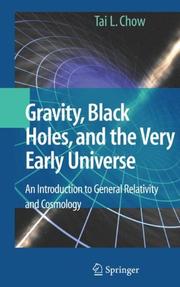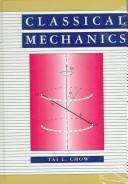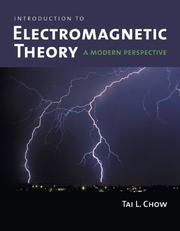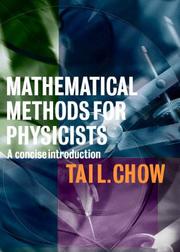| Listing 1 - 7 of 7 |
Sort by
|

ISBN: 038773631X 0387736298 1441925252 Year: 2008 Publisher: New York, NY : Springer New York : Imprint: Springer,
Abstract | Keywords | Export | Availability | Bookmark
 Loading...
Loading...Choose an application
- Reference Manager
- EndNote
- RefWorks (Direct export to RefWorks)
In the early 1900s, Albert Einstein formulated two theories that would forever change the landscape of physics: the Special Theory of Relativity and the General Theory of Relativity. By 1925, quantum mechanics had been born out of the dissection of these two theories, and shortly after that, relativistic quantum field theory. We now had in place some important ties between the laws of physics and the types of particle interactions the new physics was uncovering. Gravity is one of the four types of forces that are found throughout the universe. In fact, although it is a relatively weak force, it operates at huge distances, and so must be accounted for in any cosmological system. Unfortunately, gravity continues to defy our neat categorization of how all the forces in nature work together. Professor Tai Chow, from the California State University at Stanislaus in Turlock, lays out for us the basic ideas of Einstein, including his law of gravitation, explains the physics behind black holes, and weaves into this an absorbing account an explanation of the structure of the universe and the science of cosmology, including presenting the various models of the Big Bang, the Inflationary Universe, and the Unification of Forces. Travel with him down this engaging path to reach some fascinating conclusions, which raise even more interesting questions for the future of astronomy and physics. Says Dr. Mark Silverman of Trinity College in Hartford, Connecticut: "The author … introduces the mathematical methods essential to understanding and applying general relativity…but leaves to more advanced references derivations that a beginning student would likely find overly long and tedious…. In this way the student can concentrate on learning physics ….A strong point [is] the comprehensive discussion of the physics of black holes. Here again the author has hit just the right level of presentation: sufficient mathematical detail to demonstrate …the physical attributes of black holes…yet not so much mathematics as to lose track of the physics in an impenetrable forest of equations. An equally strong point is the discussion of the most exciting contemporary issues in astrophysics apart from black holes…".
Black holes (Astronomy) --- Cosmology. --- General relativity (Physics) --- Gravitation. --- Quantum field theory. --- Field theory (Physics) --- Matter --- Physics --- Antigravity --- Centrifugal force --- Relativity (Physics) --- Astronomy --- Deism --- Metaphysics --- Properties --- Relativistic quantum field theory --- Quantum theory --- Relativistic theory of gravitation --- Relativity theory, General --- Gravitation --- Frozen stars --- Compact objects (Astronomy) --- Gravitational collapse --- Stars --- Astronomy. --- Mathematical physics. --- Mechanics. --- Classical and Quantum Gravitation, Relativity Theory. --- Astrophysics and Astroparticles. --- Astronomy, Astrophysics and Cosmology. --- Mathematical Methods in Physics. --- Classical Mechanics. --- Classical mechanics --- Newtonian mechanics --- Dynamics --- Physical mathematics --- Mathematics --- Astrophysics. --- Physics. --- Natural philosophy --- Philosophy, Natural --- Physical sciences --- Astronomical physics --- Cosmic physics

ISBN: 0471043656 9780471043652 Year: 1995 Publisher: New York (N.Y.): Wiley
Abstract | Keywords | Export | Availability | Bookmark
 Loading...
Loading...Choose an application
- Reference Manager
- EndNote
- RefWorks (Direct export to RefWorks)
Mechanics --- 531 --- Classical mechanics --- Newtonian mechanics --- Physics --- Dynamics --- Quantum theory --- General mechanics. Mechanics of solid and rigid bodies --- 531 General mechanics. Mechanics of solid and rigid bodies
Book
ISBN: 0920063543 9780920063545 Year: 1994 Publisher: Winnipeg : Wuerz,
Abstract | Keywords | Export | Availability | Bookmark
 Loading...
Loading...Choose an application
- Reference Manager
- EndNote
- RefWorks (Direct export to RefWorks)
General relativity (Physics) --- Cosmology. --- General relativity (Physics).

ISBN: 0763738271 9780763738273 Year: 2006 Publisher: Boston Jones and Bartlett Publishers
Abstract | Keywords | Export | Availability | Bookmark
 Loading...
Loading...Choose an application
- Reference Manager
- EndNote
- RefWorks (Direct export to RefWorks)
Electromagnetic theory --- 535 --- Light, Electromagnetic theory of --- Electric fields --- Magnetic fields --- 535 Optics --- Optics --- Electromagnetic theory - Textbooks

ISBN: 1107117348 1282388959 9786612388958 0511642741 051104819X 0511556306 0511151357 0511010222 9780511010224 9780511755781 0511755783 0521652278 9780521652278 0521655447 9780521655446 Year: 2000 Publisher: New York Cambridge University Press
Abstract | Keywords | Export | Availability | Bookmark
 Loading...
Loading...Choose an application
- Reference Manager
- EndNote
- RefWorks (Direct export to RefWorks)
This text is designed for an intermediate-level, two-semester undergraduate course in mathematical physics. It provides an accessible account of most of the current, important mathematical tools required in physics these days. It is assumed that the reader has an adequate preparation in general physics and calculus. The book bridges the gap between an introductory physics course and more advanced courses in classical mechanics, electricity and magnetism, quantum mechanics, and thermal and statistical physics. The text contains a large number of worked examples to illustrate the mathematical techniques developed and to show their relevance to physics. The book is designed primarily for undergraduate physics majors, but could also be used by students in other subjects, such as engineering, astronomy and mathematics.
Mathematical physics. --- Physical mathematics --- Physics --- Mathematics --- Mathematical physics
Digital
ISBN: 9780387736310 Year: 2008 Publisher: New York, NY Springer Science+Business Media, LLC
Abstract | Keywords | Export | Availability | Bookmark
 Loading...
Loading...Choose an application
- Reference Manager
- EndNote
- RefWorks (Direct export to RefWorks)
Cosmology --- Astrophysics --- Mathematical physics --- Theory of relativity. Unified field theory --- Classical mechanics. Field theory --- cosmology --- astrofysica --- wiskunde --- fysica --- relativiteitstheorie --- mechanica --- kosmologie
Book
ISBN: 9780387736310 Year: 2008 Publisher: New York, NY Springer Science+Business Media, LLC
Abstract | Keywords | Export | Availability | Bookmark
 Loading...
Loading...Choose an application
- Reference Manager
- EndNote
- RefWorks (Direct export to RefWorks)
In the early 1900s, Albert Einstein formulated two theories that would forever change the landscape of physics: the Special Theory of Relativity and the General Theory of Relativity. By 1925, quantum mechanics had been born out of the dissection of these two theories, and shortly after that, relativistic quantum field theory. We now had in place some important ties between the laws of physics and the types of particle interactions the new physics was uncovering. Gravity is one of the four types of forces that are found throughout the universe. In fact, although it is a relatively weak force, it operates at huge distances, and so must be accounted for in any cosmological system. Unfortunately, gravity continues to defy our neat categorization of how all the forces in nature work together. Professor Tai Chow, from the California State University at Stanislaus in Turlock, lays out for us the basic ideas of Einstein, including his law of gravitation, explains the physics behind black holes, and weaves into this an absorbing account an explanation of the structure of the universe and the science of cosmology, including presenting the various models of the Big Bang, the Inflationary Universe, and the Unification of Forces. Travel with him down this engaging path to reach some fascinating conclusions, which raise even more interesting questions for the future of astronomy and physics. Says Dr. Mark Silverman of Trinity College in Hartford, Connecticut: "The author ¦ introduces the mathematical methods essential to understanding and applying general relativity ¦but leaves to more advanced references derivations that a beginning student would likely find overly long and tedious ¦. In this way the student can concentrate on learning physics ¦.A strong point [is] the comprehensive discussion of the physics of black holes. Here again the author has hit just the right level of presentation: sufficient mathematical detail to demonstrate ¦the physical attributes of black holes ¦yet not so much mathematics as to lose track of the physics in an impenetrable forest of equations. An equally strong point is the discussion of the most exciting contemporary issues in astrophysics apart from black holes ¦"
Cosmology --- Astrophysics --- Mathematical physics --- Theory of relativity. Unified field theory --- Classical mechanics. Field theory --- cosmology --- astrofysica --- wiskunde --- fysica --- relativiteitstheorie --- mechanica --- kosmologie
| Listing 1 - 7 of 7 |
Sort by
|

 Search
Search Feedback
Feedback About UniCat
About UniCat  Help
Help News
News